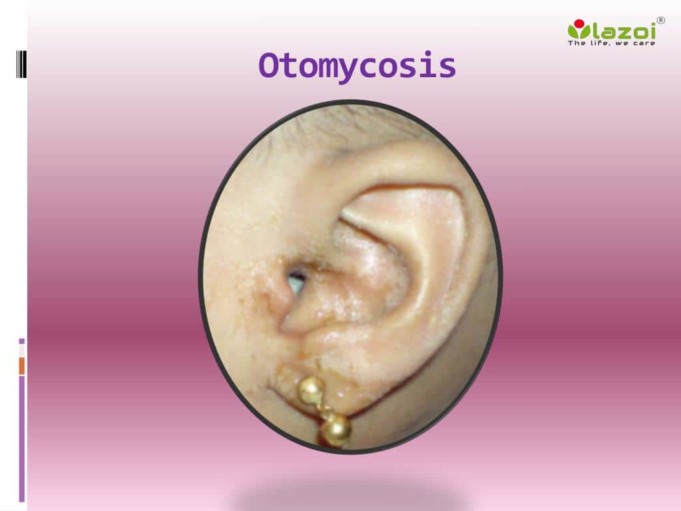Otomycosis is a fungal infection affecting one of the ears, or sometimes both. It mostly affects people living in tropical or warm areas. People who swim regularly, live with diabetes, or have other chronic medical and skin conditions are most also affected.
Otomycosis has several treatment options, but it can become severe.
Symptoms of otomycosis
The symptoms of otomycosis include the following:
- Pain
- Ringing in the ears
- Inflammation
- Swelling
- Itching
- Flaky skin
- Redness
- The feeling of fullness in the ears
- Hearing problems
- Discharge of fluid from the ears
One of the most common signs is discharge from the ears, and it can come in multiple colours. You could see the fluid in white, yellow, black, grey, or green.
Causes of Otomycosis
A fungus causes otomycosis, and there are approximately 60 different species of fungi that may be responsible for this infection. Widespread fungi include Candida and Aspergillus. Bacteria may often interact with fungi and make the condition more complicated.
In tropical and warm regions, otomycosis is more popular because fungi in these areas can grow better. During the summer months, this infection is also more widespread as fungi require moisture and warmth to grow.
Otomycosis is more likely to occur in people who swim in polluted water. The risk can be increased by also swimming or surfing in clean water.
Furthermore, individuals with compromised immune systems, ear damage or injury, eczema, or other chronic skin conditions are at a higher risk of having this form of infection.
Diagnosis
If pain and discharge occur in one or both of your ears, see a doctor. You may require medication to treat the symptoms, so an accurate diagnosis of the problem is necessary.
Your doctor will need to gather medical records and conduct a physical examination to diagnose otomycosis.
They may use an otoscope, which is an illuminated device used to look at the eardrum and ear canal within the ears. They will swab your ears to conduct laboratory tests on the discharge, buildup, or fluid. The experiments typically involve studying the organisms under a microscope.
Treatment
There are many treatments available for otomycosis. Consult a doctor to decide the right one for your fungal infection.
Cleaning
Your doctor should clean your ears properly to prevent buildup and discharge. They can make use of cleansers or other methods to clean your ears. Do not do this with a cotton bud at home or use different equipment between your ears and only around the outside of the ear should cotton swabs be used.
Ear drops
You might need to make use of antifungal ear drops to treat otomycosis. Clotrimazole and fluconazole can be used in them. Another prevalent treatment for otomycosis is acetic acid. Typically, a 2 per cent solution of these ear drops is used multiple times a day for about a week. Using 5 per cent of aluminium acetate ear drops is yet another solution.
Oral medications
Some fungal infections like Aspergillus may be immune to the normal ear drops. Oral drugs such as itraconazole (Sporanox) may be required for them. Over-the-counter medicines that include nonsteroidal anti-inflammatory drugs or acetaminophen (Tylenol) can also be recommended for discomfort.
Topical medications
If the fungus affects the outside of your ear, your doctor may prescribe topical antifungal otomycosis medicine. These generally come as ointments or creams.
Home remedies
Otomycosis can be treated with some home remedies, but speak to a doctor before you try them. It can help to remove buildup from your ears by diluting hydrogen peroxide.
Over-the-counter medicines containing carbamide peroxide can also help to clear the wax from your ears. Using an ear-drop solution of equal amounts of white vinegar and rubbing alcohol is another alternative after swimming.
You can also keep water out of your face by using a swim cap or earplugs. You may need to use tools like a hairdryer, which produces dry air to reduce the moisture content from the ears. Ensure that you make use of the lowest level and avoid putting your ears too close to the hairdryer.
In most cases, Antifungal medications are adequate to get rid of otomycosis. Nonetheless, some individuals may not respond to these procedures, and otomycosis can become severe. It could be helpful in this situation to be under the guidance of an ear specialist (otolaryngologist).
If your symptoms worsen, follow – up with your doctor. It is crucial to get these conditions under proper control if you have diabetes, a compromised immune system, or chronic health problems.
It’s also essential to treat any chronic skin conditions, including eczema. Constant exposure from polluted water or other sources to the fungus may cause the infection to return.
Prevention tips
There are certain things you could do to help prevent otomycosis, and they include:
- Avoid having water in your face while surfing or swimming
- Wipe your ears after bathing
- Stop putting cotton buds inside your ears
- Stop scratching the skin around and inside the ears
- Make use of Acetic acid ear drops after you get water in your ears












